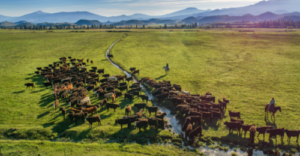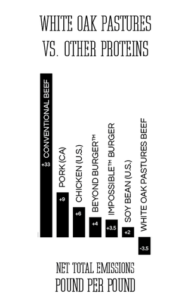Meat is one of the most nutrient-dense foods around. Pound for pound, it is hard to find a food source with more protein, iron, and specific vitamins and minerals in food than meat. Like much, though, quality matters! The quality matters for your health, the animal’s welfare, and the environment. It’s why when it comes to consuming beef (if you so choose to eat meat), there should only be one way of going about it. That is, consuming meat that is 100% grass-fed and regeneratively raised. If you are a meat-eater, strongly consider eating less or no conventional raised meat that comes from Concentrated Animal Feeding Operations (CAFOs). CAFOs make up 99% of beef on the market and are from cows fed a cheap grain-based diet, injected with hormones and antibiotics, and cows and other livestock that live in unsterile and confined living conditions. The type of meat (nutritional and taste), the well-being of the cow, and the environmental impact are entirely different when it comes to free-range, grass-fed cows versus cows from a factory feedlot.
For You
The nutritional profile from grass-fed cows to feedlot cows is vastly different. Industrial beef from CAFOs is noticeably inferior to grass-fed beef when it comes to the omega-6 to omega-3 ratio. Why is this ratio important? Having a higher proportion of omega-6’s to omega-3’s in the diet promotes the pathogenesis of many diseases, including cardiovascular disease, cancer, and inflammatory and autoimmune diseases. Grass-fed beef contains higher amounts of omega-3 fats, keeping the ratio of omega-6’s to omega 3’s closer to 1:1, where feedlot beef, omega-3’s are hard to be found, putting the ratio closer to 20:1 and in some instances, as much as 50:1! Today the average person has a 16:1 omega-6 to omega-3 ratio eating the Standard American Diet (SAD), where the ideal ratio falls between 2:1 and 4:1.
Grass-fed beef is also higher in vitamins and minerals, particularly Vitamin B, Vitamin E, Vitamin K, and trace minerals like magnesium, calcium, and selenium. What the cows eat is extremely important for the quality and the nutritional makeup of the meat. The cheap corn and soy diet of cows from industrialized meat is far inferior nutritionally to the diet of grass-fed cows.
If you are not concerned about the superiority of grass-fed meat versus factory-farmed meat, maybe the taste will change your mind. Grass-fed beef is leaner, more robust, and tender than industrialized meat. The only way to know is to try it yourself!
For the Cow

CAFOs plain and straightforward are inhumane. They can house anywhere from hundreds to millions of animals, some conditions being worse than others. Animals in CAFOs spend their entire lives in cramped and unsanitary conditions. They are often forced to endure living on concrete with no access to pasture, fresh air, or natural light. The CAFO industry does not allow the animals to express their natural behaviors, and they are no
longer viewed as living, feeling beings.
On the contrary, pasture-raised, grass-fed cows roam freely and graze on open fields, munching on green grasses, and can express their natural herd behaviors. Their diet contributes directly to their natural growth and health. Their quality of life is exponentially better than cows from CAFOs as they experience the open air, fresh feed, and low-stress handling techniques.
The quality and safety of the animal products you eat are directly linked to the health and welfare of the food animals.

Grass-fed cows from Belcampo Farms in Shasta, CA
For the Planet
Mark Hyman, in his book, Food Fix, states how “no sector has more power to reverse global warming and climate catastrophe than our food system.” CAFOs are a significant contributor to greenhouse gases, deforestation, water and air pollution, and depletion of water resources from irrigation to grow feed crops. Even reducing the fossil fuel to zero through electric cars and more solar and wind power, the expansion of CAFO meat production could still produce enough greenhouse gas emissions to raise global warming by 2 degrees Celcius. Cattle feedlots are a large
part of the climate change scourge on the planet.

On the other hand, regenerative farming and well-managed grazing of the cows can
reverse carbon emissions in the atmosphere. White Oak Pastures, a regenerative farm in the Midwest found that rotating the cows on open pasture put more carbon back into the soil (where we need it) than into the air (where it does harm). Rotating livestock produced a climate-positive and carbon-negative footprint! The Marin Carbon Project in California also proved that properly managed grasslands through grass-fed cattle could remove carbon from the atmosphere. In
a robust study comparing feedlot beef to grass-fed cattle, including all outside inputs and methane, the grass-fed operations reduced net carbon by 170%. The feedlot beef increased emissions. Fortunately, there are more and more regenerative farms like White Oak Pastures. People vote with their dollars, and one of the best ways for these farms to continue to grow and expand is by supporting them by buying their products. 
Again if you choose to eat meat, eat good meat. 100% Grass-fed, regeneratively raised meat from animals that were raised humanely. It is good for you, the animals, and the planet. Currently, my go-to stops for purchasing meat I trust are from Belcampo Farms and Butcher Box. You can order your meat online and have it delivered to your door.
To MAShealth,
Michael
Sources:
Belcampo Meats Brochure
Food Fix by Dr. Mark Hyman
https://blog.whiteoakpastures.com/blog/carbon-negative-grassfed-beef